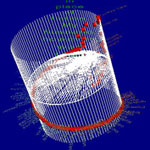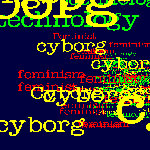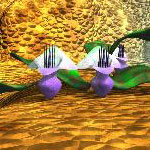High Performance Computing in the Arts & Humanities
Printer-friendly| Project | Details | Discipline | Type of HPC | |||
Big See Original Image: http://tada.mcmaster.ca/Main/VersionBeta3 |
Abstract: SHARCNET & TAPoR have collaborated to explore the use of HPC in text analysis. Contact:
|
Text Analysis | Visualization | |||
| MONK | Abstract: Growing out of the NORA Project, Monk is a collaborative effort through several North American universities, focused on expanding the possibilities of text analysis through visualization of text in a 3-dimensional space. Contact: |
Text Analysis | Visualization | |||
| POS Tagging XML with xGrid and the Stanford Log-linear Part-Of-Speech Tagger |
Abstract: Posted by Matthew L. Jockers at Stanford University, this is a how-to webpage, describing the use of xGrid, to speed up the computing time of a part-of-speech tagging project. It gives four very practical examples of how HPC can be used to increase productivity in humanities research. Resources: |
Text Analysis | Grid | |||
| ReACH | Abstract: The ReACH (Researching e-Science Analysis of Census Holdings) Project, is based in the School of Library, Archive, and Information Studies at UCL (University College London). Objectives of the ReACH project include developing interdisciplinary expertise and discussing the application of e-Science technology to Humanities projects, with particular focus on historical census records. Contact: |
History | Grid, Mass Storage | |||
| Language Visualization and Multilayer Text Analysis  Original Image: http://www.nbb.cornell.edu/neurobio/ land/OldStudentProjects/cs490-95to96/tonyg/Palim.gif |
Abstract: The Visualization Group at Cornell Theory Centre has developed a prototype tool that can study language/discourse phenomena in three-dimensional space. With this tool, the group is now developing new techniques for reading & interpreting the textual data. Contact:
|
English, Critical Theory, Text Analysis | Visualization | |||
| Gridcast | Abstract: The Belfast e-Science Centre (BESC) and the BBC are finding solutions to storing and organizing vast archives of video content. Contact: |
Media & Communications | Mass Storage, Parallel Processing | |||
Spirited Ruins Original Image: http://scv.bu.edu/visualization/hipart/images/spirited_ruins.jpg |
Abstract: Boston University's HiPArt project uses HPC to generate this interactive 3-D space. Contact: |
Visual Art | Visualization | |||
TereDRE |
Abstract: Contact:
|
Visual Art, 3D Animation |
Visualization, Grid | |||
| SIDGrid | Abstract: Argonne National Laboratory, The University of Chicago, and The University of Illinois at Chicago have created The Social Informatics Data (SID) Grid which is designed to help researchers store, explore, analyze and annotate multimedia data using grid technology. Contacts: |
Language, Cognition, and Social Behavior | Grid & Mass Storage | |||
| Cornell University: The Web Lab |
Abstract: Cornell University and the Internet Archive have teamed up to build The Web Lab, which provides researchers with "a relational database with metadata about Web pages, and a data analysis cluster...with support for map/reduce programming."1 Contact: |
Communication, Media | Cluster | |||
| The Library of Congress: Digital Preservation |
Abstract: The Library of Congress leads a collaborative effort to collect and archive digital information for future generations, with particular focus on those materials available only in digital formats. Contact: |
History, Communication, Media | Mass Storage & Parallel processing | |||
| USC Shoah Foundation Institute: Video History Archive (VHA)  Original Image: http://college.usc.edu/vhi/ instituteataglance.php#link_01 |
Abstract: The USC Shoah Foundation Institute for Visual History and Education has archived a library of 52 000 video testimonies of Holocaust survivors and witnesses. Contact: |
History, Sociology, Cultural Anthropology | Mass Storage | |||
How can I learn more about HPC in the Humanities & SHARCNET facilities?
1 The Web Lab. "The Web Lab: A Joint Project of Cornell University and the Internet Archive." 7 [July 13, 2008] <http://weblab.infosci.cornell.edu/>.


